Name:WANG Qingfeng
Tell:
Email:qfwang@wbgcas.cn
Organization:Wuhan Botanical Garden
CGTN: New Study Sheds Light on Baobab Trees' Evolution
2024-05-17
A study on baobab trees has shed light on their origin and evolution, according to the Wuhan Botanical Garden (WBG) of the Chinese Academy of Sciences (CAS).
The baobab tree, an iconic species in Madagascar, can live more than 2,000 years and provide food, water and shelter for local communities. The species holds significant cultural, economic and ecological importance.
The study, led by the WBG and the Sino-Africa Joint Research Center, was published in the journal Nature on Wednesday.
In the study, scientists performed a series of genomic analyses on the whole genome sequence of all extant eight baobab species to reveal the origin and evolutionary history of the lineage of baobab trees.

Researchers measure a baobab tree (Provided by the WBG)
Among the eight baobab species, one is widespread in the savannahs of the African continent, one is found in northwest Australia, and six are endemic to Madagascar. Madagascar is the center of origin for baobabs, and species endemic to Australia and mainland Africa are sister clades to the Madagascan baobabs, according to Wang Qingfeng, director of the WBG of the CAS and director of the Sino-Africa Joint Research Center of the CAS, in an interview with CGTN.
The study reveals that the distribution and number of individual baobabs in Madagascar were influenced by interspecific competition and the geological history of the island, particularly changes in local sea levels. Researchers suggest that reevaluating the conservation status of baobabs in Madagascar is necessary, with additional considerations for interspecific competition and potential hybridization.
In addition, the study suggests that the conservation status of two baobab species in Madagascar, Adansonia suarezensis and Adansonia grandidieri, should be re-classified due to the serious threats they face to their survival. Their limited genetic variability, small population sizes and narrow ecological niches make them vulnerable to climate change and other environmental pressures.
The Sino-Africa Joint Research Center, established in 2013 as a platform for scientific cooperation between Chinese and African scientists by the WBG and Jomo Kenyatta University of Agriculture and Technology, Kenya, has conducted numerous scientific research projects in fields such as wildlife conservation, water quality evaluation, and food supply security enhancement. (CGTN)